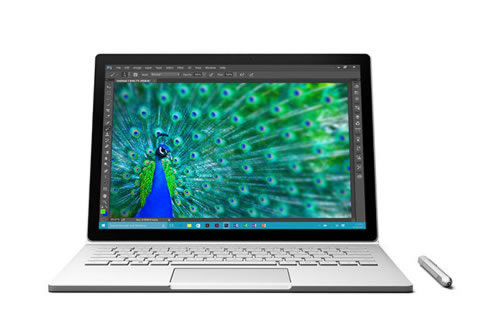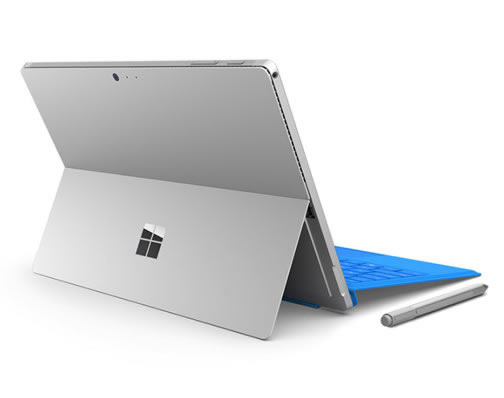|
|
||||
The Surface Book is the larger and most "laptop-like" of the pair. It's a beautifully slim and classy box that not only looks kind of like a Mac laptop, but whose screen not only offers terrific resolution (though not a 16x9 aspect ratio, if such is important to you), it can be swung around to use as a tablet or removed completely for those times you want to leave the keyboard at home and have just a tablet.
Microsoft sent me the Surface Book, Core i5 with a 256 gig solid state hard drive and eight gig of RAM. It's the middle of the three model line and retails for a heady $2199, which is definitely a sizeable chunk of change in a world where you can get a reasonable laptop or tablet for about five hundred. That's a bit of an "Apples to Oranges" comparison, however, since the Surfaces are so marvellously flexible and offer a lot more power than a low end laptop.
The Surface Pro is a more conventional tablet, in that you get a flat panel (with stylus) and if you want a keyboard/cover you have to spend extra on it. Fortunately, Microsoft included the keyboard/cover which, at $170 above and beyond the unit's $1180 to $2100 price (depending on its configuration), seems a tad dear. On the other hand, the keyboard works really well as both a keyboard and a cover, and I actually preferred its feel to the one on the fully fledged "laptop." Go figure.
Why did I prefer the "portable" keyboard? As a writer, I do a lot of typing – at about 80 words per minute not including typos – and I'm a tad anal about my keyboards. I hate most laptop keyboards but this one feels really good under the fingers and I can type on it very well. It's one of the best portable keyboards I've used and the fact that it doubles as a screen protector is a nice bonus.
 You can also partake of an onscreen keyboard (on either type of Surface), which is meant for when you're in tablet mode, though Microsoft's virtual keyboard pales in comparison with the one on my iPads in its general functionality and ease of use.
You can also partake of an onscreen keyboard (on either type of Surface), which is meant for when you're in tablet mode, though Microsoft's virtual keyboard pales in comparison with the one on my iPads in its general functionality and ease of use.
Click on the image to open a slideshow.
Between the detachable keyboard, the on screen one, and the stylus pen (which is magnetized to hang off the side of the screen, a handy way of helping prevent losing it), you have a nice variety of input methods, and that doesn't' include the fact that you can also use the screen as a tablet's touch screen.
As a touch screen, both units would lock up briefly periodically, but it wasn't a big deal.
The Pro also features a handy, fold out panel on the back of the screen you can use to prop it up, on your lap, on a flat surface or whatever. It was especially handy when typing with the optional keyboard.
Both of these Surfaces give you an interesting and unusual aspect ratio of 3:2, rather than 4:3 or 16:9, but it works fine. And the resolution of 3000x2000 means what's on the screen looks really, really good - not 4K but darn fine anyway. Microsoft's sample Surface Book had a 13.5 inch display; the Pro's was 12.3 (with a resolution of 2736 x 1824). Both are larger than the 4:3 screen on my iPad Air, which can be handy (depending on what you're doing on the computer) though the downside could come in their decreased portability compared with the iPad.
That said, I had no issues hauling around even the larger Surface and their extra size wouldn't turn me off at all - especially if I want to watch movies on them. And of course the fact that they're honest to goodness Windows computers means they're more suitable tools for working than a standard tablet, depending on what that work might be of course. For example, I'd rather write a column or update my website via the Surface rather than the iPad.
The Book is a tad heavy for a tablet, but the smaller, "keyboardless" Pro has less heft and is more in line with what one would expect from a tablet.
To me, the most interesting thing about both of these Surface products is their flexibility. I can't help but compare them, thanks to their small size, to the iPad (though the Book might be compared more accurately with a similar Mac portable) or its Android competitors, but tablets are more of an appliance, "dumbed down" computers that are most suitable for surfing the web, email, games and stuff like that, than a real portable computer for work.
That may not be fair to the tablets, which can be used as portable computers in a pinch, but the Surfaces blow them out of the water in flexibility, especially compared to the iPad. This added functionality includes the Surfaces' USB inputs that let you move files, add peripherals or whatever, just as you'd do with your desktop PC. It has always bothered me that you can't even bring files into the iPad via USB, which seems like a major oversight on the part of Apple, but it hasn't been enough (yet, anyway), to make me want to dump my iPad Air.
Besides the screen freezings, I had some other weird experiences with the Surfaces, though nothing I would consider a deal breaker were I shopping for this type of system. For example, if the battery didn't have some charge in it I couldn't separate the Book's keyboard section from the rest. My only other real issue was the weird connector for the power supply, which seems rather flimsy and easy to disconnect accidentally. It almost seems as if they're trying to come up with their own version of Apple's Lightning connector, in that the plug works in either direction, but it doesn't connect as solidly as Apple's input.
One thing I really liked about the Surfaces was the flexibility of input. Since I'm older and more forgetful - and old habits die hard - I find myself reaching for a mouse when using my tablet, and reaching my finger out to the screen (which isn't a touch screen) when on my PC. With the Surfaces, either method will work, plus there's the stylus. And of course if you don't like trackpads you can add a mouse via USB.
I also loved the fact that all the PC software I tried on the Surfaces worked as well on them as they do on my Windows PC - so instead of having to use the iPad's Mickey Mouse word processor I could use the full Microsoft Word - and the rest of the Office suite - and it also plays the PC games that I tried on it.
Microsoft's new Surface line hasn't made me want to abandon my iPad, especially considering the price differential, but if I were buying a PC today I'd be giving the Surfaces - especially the Pro - a good look. They're just that good, that powerful, that flexible - and that cool.
Copyright 2016 Jim Bray
TechnoFile.com
Jim Bray's columns are available through the TechnoFile Syndicate.
